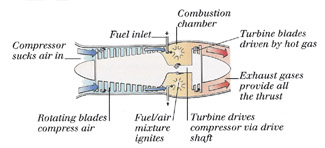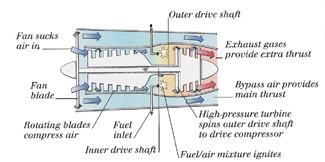Jet Engines (Part 1)
Turbojet

http://www.aeromuseum.org/Education/Lessons/HowPlaneFly/HowPlaneFly.html
The most basic jet engine is the turbojet. As soon as the air enters the front of the engine, the blades of the compressor, compresses the air before funneling it into the combustion chamber. During the compression, not only is the density of the air increased by compressing it in a confined chamber, but the temperature of the air also increases as the air molecules of squeezed closer together.
The resulting air that emerges into the combustion chamber is thereby preheated, and the amount of oxygen per volume is increased to facilitate combustion. This becomes an important factor at increased altitudes, where the air density (and thus also oxygen density) decreases. In the combustion chamber, fuel mixes with the air before being ignited.
As the air-fuel mixture is burned, the gases expand so that the pressure is increased further. Part of this energy is captured by the turbine blades and translated into the rotation of the compressor shaft, and thereby supplying the energy the compressor needs to function.
The rest of the hot gases are forced through the necked-down exhaust nozzle, thus accelerating them further. The force of the hot gases expelled in the exhaust, provides all of the planes thrust.
Turbofan
http://www.aeromuseum.org/Education/Lessons/HowPlaneFly/HowPlaneFly.html
This a modified turbojet engine in which part of the air compressed in the compressor completely bypasses inner engine core housing the combustion chamber and turbine. Since the bypassed air is compressed and thus moves with a greater velocity the air outside the engine, it provides a little bit of thrust in addition to that generated in the inner engine.

